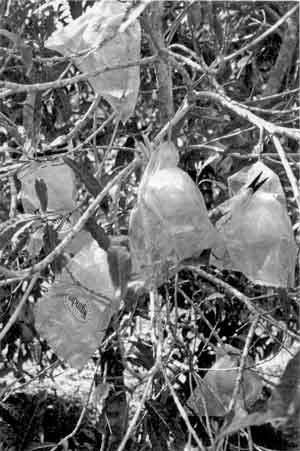
To Bag or Not to Bag?
We all know that fruit fly is really a problem for
the Abiu. Here in Julatten, our main crop ripens in early February to
March, just when there is heavy rain and the fruit fly is very active.
Besides the fruit fly problem, the rain causes the skin of the Abiu to
split on occasional fruit, and when this happens, the birds attack them
or they soon rot and fall.
A solution to most of these problems is to bag the fruit.
Previously
I have covered the fruit with paper bags to prevent fruit fly, but the
rain eventually softens the paper and it falls apart, or the birds and
flying foxes find the paper easy to tear (otherwise the paper bags work
well against fruit fly).
I also have tried fabric bags. They
worked quite well too against fruit fly, birds and flying foxes but it
is hard to see the ripening fruit through the bags.
Bagged fruit is becoming the way of saving fruit from insect damage overseas, so I still believe it is the way to go.
I have now tried a new bag.

The Gray abius ripening in the bag
It
is a very thick, clear plastic bag with pleats in the side. I bought
the bags from the ice works. Sausage bags, they call them. It is a long
bag and I manage to cut three bags out of one. I use the stapler to
clip the bottoms of the bags, or on the sealed ends I snip off the
corners so the end of bag is sealed from birds and flying foxes but is
able to let water out and air in to circulate.
As I put the bags
over the green two-inch-long fruit, I puff out the bag so the plastic
bag keeps away from the fruit. I then gather in the top of the bag,
fold it over the branch and secure it with a clothes peg.
I also
use thick plastic rolled-oats bags. They have a little extra, as the
label supplies a little shade to the fruit. I use these in situations
really exposed to the sun.
If only someone would make
fruit-covering bags commercially. I'd like to see a tough see-through
material with one side of the bag shaded (something like a banana bag).
These bags could be used several times over.
James Sing
mentioned at our previous meeting that the Taiwanese have produced a
chemical-impregnated paper bag with a wire at the top and all you have
to do to secure the bag is to squeeze the wire. This idea could be
incorporated into a stronger all-weather bag.
Well, the thicker
plastic bags are proving to be most successful. It has stopped fruit
fly and flying foxes and birds have not ripped any bags open. The big
advantage of the clear plastic bags is that you can easily see at a
glance when the fruit is ripe.
We
are still having a problem occasionally with the skin of the Abiu fruit
splitting on a few of the fruit, but I think it must be due to the tree
taking in such a lot of water during heavy rain. The fruit that does
split in the bags is still good and can be eaten for home consumption.
The
main crop on our Abiu trees is so heavy with fruit the branches break
with the weight. Propping the branches with forked sticks prevents
this, but next year, thinning of the fruit will reduce a lot of the
weight and more even-sized fruit will be produced. The Gray Abiu can
get quite big - 2 lb. has been our biggest.
I have found the
best time to pick the 'Gray' Abiu is when the fruit is completely
yellow, usually two weeks after the fruit begins to turn yellow. If
picked and eaten before the fruit is completely yellow, the fruit does
not have the best flavour and it has a lot of latex around the skin.
When completely ripe, the fruit is of the sweetest, caramel, nectar
flavour and latex is reduced to a minimum.
Picking and packing
the fruit has to be done carefully, as the fruit can be easily bruised.
Packing them with newspaper or tissue paper in between each fruit will
prevent bruising. The fruit is best packed in single layer boxes also,
to prevent bruising.
Yes, it does take a bit of time and effort
to bag the fruit, but one soon gets the knack and can do it quicker
every time. It is well worth it though, as when you bite into that
blemish-and-poison free Abiu you know you have got it in the bag!
Back To
Bagging Page
|

